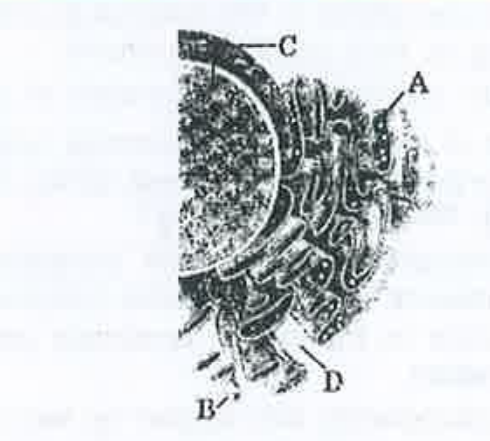Complete Solutions to ARCHIVES of chapter CELL: STRUCTURE AND FUNCTIONS of Class 11 book with complete answers and questions
| Class 11 | BIOLOGY |
| Chapter | CELL: STRUCTURE AND FUNCTIONS |
| CENGAE BIOLOGY | ARCHIVES |
| Number Of Questions | 50 |
| Academic Year | 2023-24 |
Which one of the following is not a part of cell membrane ?
01:59View SolutionSelect the wrong statement from the following
03:25View SolutionVacuole in a plant cell
02:57View SolutionThe two sub- units of ribosomes remain united at a critical ion level of
02:58View SolutionCellulose is the major component of cell walls of
02:09View SolutionPolysome is formed by
03:10View SolutionKeeping in view the fluid mosaic model for the structure of cell membrane which one of the following statement is correct w.r.t. the movement of lipids and proteins from one lipid monolayer to the other ( described as flip- flop movement ) ?
05:50View SolutionMiddle lamella mainly contains
04:24View SolutionStroma in the chlorplasts of higher plant contains
04:37View SolutionCytoskeleton is made up of
02:19View SolutionPlasmodesmata are
03:48View SolutionThe plasma membrane consists mainly of
04:26View SolutionThe main arena of various types of activities of a cell is
02:47View SolutionWhich one of the following has its own DNA ?
04:57View Solutionwhich one of the following structures between two adjacent cells is an effective transport pathway?
02:05View SolutionIdentify the components labelled A, B, C and D in the diagram below from the list (i) to (viii) given along with

Components :
(i) Cristae of mitochondria
(ii) Inner membrane of mitochondria
(iii) Cytoplasm
(iv) Smooth endoplasmic reticulum
(v) Rough endoplasmic reticulum
(vi) Mitochondrial matrix
(vii) Cell vacuole
(viii) Nucleus
The correct components are04:48View SolutionAn elaborate network of filamentous proteinaceous structures present in the cytoplasm which helps in the maintenance of cell shape is called
04:21View SolutionWhat are those structures that appear as 'beads'-on-string' in the chromosomes when viewed under electron microscope?
02:39View SolutionPeptide synthesis inside a cell takes place in
02:54View SolutionImportant site for formation of glycoproteins and glycolipids is
03:24View SolutionGiven below is a sample of a portion of DNA strand giving the base sequence on the opposite strands. What is so special shown in it?
5' _____________ GAATTC' ___________3'
3' __________ CTTAAG _____________ 5'02:55View SolutionThe correct sequence of cell organelles during photorespiration is
03:11View SolutionWhat is true about ribosomes ?
02:32View SolutionSelect of correct statement from the following regarding cell membrane
" Or"
Who proposed "fluid mosaic model" for plasma membrane02:36View SolutionNuclear membrane is absent in
03:52View SolutionWhich one of the following does nto differ in E. coli and Chlamydomonas ?
01:58View SolutionRibosomal RNA is synthesized in `:`
01:07View SolutionA major site for synthesis of lipids is
02:22View SolutionWhich one of the following organelle in the figure corretly matches with is function ?
 01:47View Solution
01:47View SolutionMatch the following and select the correct answer
 02:20View Solution
02:20View SolutionThe osmotic expansion of a cell kept in water is chiefly regulated by
02:06View SolutionThe solid linear cytoskeletal elements having a diameter of 6 nm and made up of single type of monomer are known as .
04:53View SolutionWhich structures perform the function of mitochondria in bacteria?
02:34View SolutionSelect the correct matching in the following pairs
01:15View SolutionWhich one of the following is not an inclusion body found in prokaryotes?
02:28View SolutionNuclear envelope is a derivative of
01:17View SolutionDNA is not present is
02:43View SolutionWhich of the following structures is not found in prokaryotic cells?
02:06View SolutionWhich of the following are not membrane- bound?
03:19View SolutionCellular organelles with membranes are
04:57View SolutionCell wall is absent in
03:24View SolutionA protoplast is cell
01:44View SolutionMatch the columns and identify the correct options
`{:(,"Column I",,,"Column II"), (1.,"Thylakoids",,(i), "Disc-shaped sacs in Golgi apparatus"), (2.,"Cristae",,(i),"Condensed structure of DNA "), (3., "Cristarnae",,(iii), "Flat membranous sacs in stroma"), (4. , "Chromatin",,(iv), "Infoldings in mitochondria"):} `01:58View SolutionBalbiani rings are sites of
02:11View SolutionMitochondria and chloplast are
(i) Semi-autonomous organelles
(ii) Formed by division of pre -existing organelles and they contain DNA but lack protein synthesizing machinery.
Which one of the following options correct ?04:31View SolutionMicrotubules are the constituents of
01:11View SolutionA complex of ribosomes attached to a single strand of RNA is known as
03:37View SolutionWhich one of the following cell organelles is enclosed by a single membrane ?.
01:09View SolutionWater soluble pigments found in plant cell vacuoles are
01:40View SolutionA cell organelle comtaining hydrolytic enzyme is
01:21View Solution
ARCHIVES questions and complete solutions for chapter CELL: STRUCTURE AND FUNCTIONS of CENGAGE BIOLOGY (ENGLISH) of Class 11
